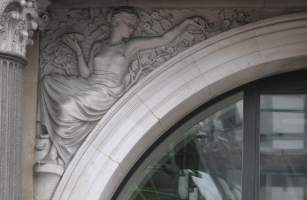
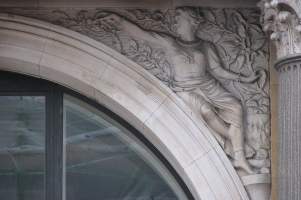
Archetypical pair of spandrel girls.
Archetypical pair of spandrel girls.

Among all the architectural positions for sculpture, the spandrel is one of the most excellent. A spandrel refers to the roughly triangular shape made when an arched door or window is enclosed by some rectangular surround. If we extend upwards from the vertical side of the arch, then form a right angle and move inwards horizontally till we touch the highest point of the arch, the shape thus enclosed is the spandrel.
The purest spandrel, then, is a triangular shape with the longest side curved inwards. There are two frequent variations to the spandrel shape. Firstly, if the horizontal at the top of the portico is raised a distance above the arch, then a four-sided shape is formed, either a truncated version of the triangle with one curved side, or if raised further, a more blocky shape, or rather two such shapes joined in the centre. At its ultimate, we have a horizontal panel with an upwardly curved base. We may refer to the range of such shapes ‘raised spandrels’.
If, however, the arch does not fill the width of the portico, so that there is a space to left and right, then we get a different four-sided shape, as if a horizontal rectangle with one side squeezed in – we can reasonably call this a ‘widened spandrel’ or ‘broadened spandrel’. It is not uncommon for the spandrels to be both widened and raised, when the arch is rather smaller than the portico around it, and in this case we have a triangle, as ever with the long diagonaol side curved, but now the points at each end truncated, to give an irregular five sided figure which approximates very roughly to an oval.
On this page, we will look at a number of examples of spandrel sculpture, including raised and widened spandrels. We should note first though that the shape between a pair of arches and a horizontal straight is also known as a spandrel. This is a very different triangle, down-pointing, with two curved sides, and symmetrical, admitting a different type of composition, and we refer to it here by the term ‘double spandrel’.
The right and proper subject for a spandrel is unquestionably the female figure. She sits or reclines on the curved edge, facing away from it, or outwards to the viewer; one or both feet is pushed downwards into the narrow, downpointing corner, and she may, or may not, extend one arm into the narrow horizontal corner, either the outstretched arm as in the picture above, or just the elbow. This one above is a sophisticated example, easy in poise, perfect in composition, and in her pose occupying the whole of the spandrel space bar a little square in the top right corner, which is filled by the little cherub.
Below left we have a simpler example, a solid little allegorical figure of Agriculture, holding a sickle and ears of corn in one hand, to fill the right angle, and with a cornucopia in her other, the produce of the harvest spilling out to fill the horizontal angle. Her feet point down into the vertical corner, thought not so far. he central matched pair of spandrel girls are reversed, facing away from the viewer, and exemplify the elbow towards the horizontal corner, the narrow point being filled by a leafy branch. The feet here are tucked as far as conceivable down into the vertical corner. The girl below right is completely different in outline; she still sits facing outward from the curved side, and an elbow points inward, but it is drawn in so that a substantial triangle is left in the horizontal corner. Echoing this, her legs too are drawn up so that they do not fill the downward pointing corner; instead, we see a portion of a globe on which her foot rests, her other supports being clouds. The rest of the outer space is filled by her swirling art nouveau robe and a small angel by her shoulder.
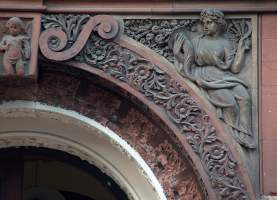
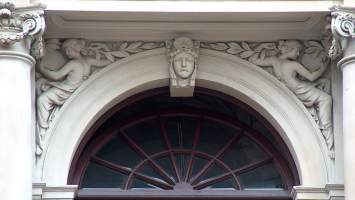
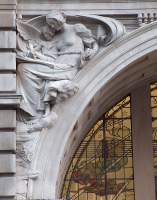 Spandrels with female figures.
Spandrels with female figures.
Another example below left, an imperial creature of Victorian Hellenism, with symbols of empire behind of Big Ben and the dome of St Paul’s Cathedral. The pose of the figure is one we will encounter several times further down this page. Below right, a nude, showing a typical pose of body and limbs concealed in part by drapes in our clothed examples. As with the girl to the left, her arm stretches out along the narrow horizontal corner, but here to rest upon one of two small, vigorously swimming dolphins.
Some cases now with other figures – we start, unusually, which cherubs or putti, which are acceptable for use in spandrels. Firstly a pair in a single spandrel, and a single one in the double spandrel, his musical instruments and a trailing drape effectively filling the space. Another putti example in the centre, showing two treatments of the figure – the single spandrel has the figure as for a spandrel girl, foot stretched down into the corner, and with the other long corner filled by a cornucopia, the rear arm and hand, which holds a bunch of grapes on which the little Bacchic figure is to gorge, filling the squared-off corner. The figure in the double spandrel likewise has a foot extended down in to the long corner, but her is standing, and fills only the centre of his space, the remainder being filled with Acanthus leaves and stylised flowers. Then on the right, a pair of putti in rather shallow spandrels. The pose is familiar, facing outwards, feet down in the corner (which is fuller because of the shallowness of the spandrel), and here the very long horizontal corner filled with a piece of drapery which they hold at each end, with again something of a backing of acanthus and a flower – a poppy in this case.
Cherubs as spandrel sculpture.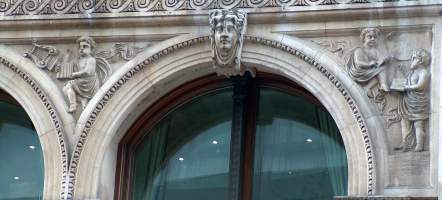
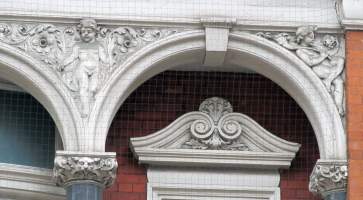

Below left, a brutal little murder scene carved in a medieval spandrel on a church in Norwich, decayed but still dynamic and vigorous in aspect. Then a 19th Century example in a medievalised style, combining a primitive terra cotta figure with spade, a couple of bulrushes suggesting he is some fugitive in a marsh, also a cartouche and some hanging drapes, all in a small broadened spandrel. And another medieval example, though obviously much recut, again in Norwich but this time from the Erpingham Gate. We see a man with a sword and small buckler climbing among a winding grapevie, pursued by a small lion. The man’s sword and arm extend into the horizontal corner, the lion into the downward corner, and the rest is filled by the vine.
With this lion, let us turn to other animal sculpture in spandrels. On the extremely shallow spandrel above a Tudor-style arch, we see a pair of monsters, one of catlike form, the other something between a greyhound and a dragon; in each case their curly pointed tails extend into the long horizontal corners. Then a long fish, sinuously turning among foliage to grab a hapless smaller fry in its powerful jaws. And an example to show that a spandrel can be filled with a full statue rather than just high relief carving, shown by a heraldic dragon perched on a short pedestal next to a Baroque arch.
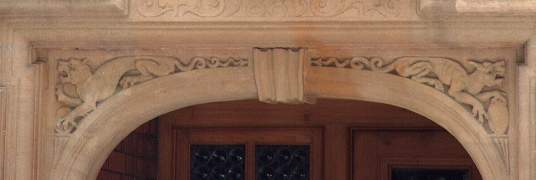
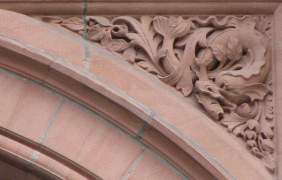
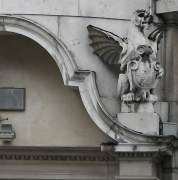 Carving of monsters in spandrels.
Carving of monsters in spandrels.
The fish example shows the use of vegetation to fill the spandrel, and here are some other examples of this. First an exquisite design of oak leaves and berries on some olive-like plant. Next, pairs of small spandrels flanking keystone heads on a three-light window, the floralities including some sort of sunflower design in terra cotta. The side-window spandrels are cut down to irregular quadrilaterals, but still accommodate some variety of floral décor. The third example, in the bright red terra cotta characteristic of Birmingham, has little heads among the foliage. Then an example in what we may presume to be Doulton white tile, a simple elegant design with the leafy branches commencing in the long vertical corner, and curving round to terminate in the horizontals, with the right angle filled by small side branches. And to the right, a contrasting coloured tile composition with an almost symmetrical design where the emphasis is on the right angle with the long corners playing a subsidiary role.
Spandrels filled with sculptured leaves.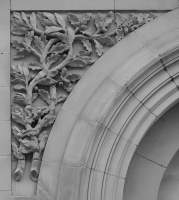
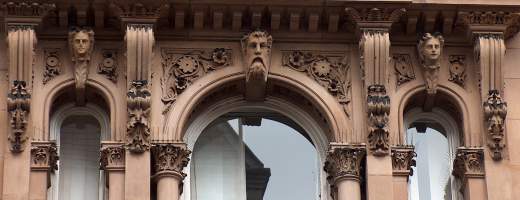
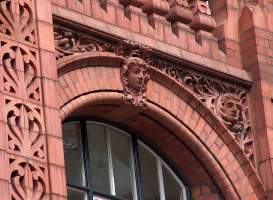
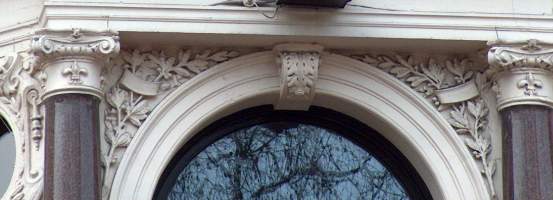 a
a
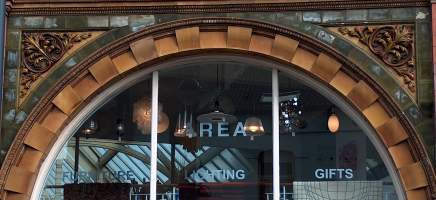
An alternative for space filling sculpted decoration of the spandrel, based on a medieval concept which underwent periodic revivals during Victorian and Edwardian times, is the use of ribbon-like decoration (strapwork, if you will) together with grotesques. Grotesques are simply figures, or animals, which have been made wholly subsidiary to the demands of ornament; my understanding is that the term ‘grotesque’ arose from the type of ornament rather than the type of ornament was described dismissively by the term grotesque. The first two examples below left, both from Leeds, where architectural grotesques are much used, are typical. We see half-figures dissolving at about waist level into Acanthus leaves and scrolls, with the proportion of these ornaments being such as to suggest the lower part of the figure without looking disproportionate. Skillful work, and yet rather more uneasy and almost disturbing to the modern eye than they would have appeared in the 19th Century, or earlier. The first example has raised the spandrels (or lowered the arches) to the point where we have almost a frieze running along the top, but the design emphasises the spandrel positions and the arising of the grotesque half-figures from the long vertical corners. The third example is a broadened spandrel bearing a single figure, whose arms dissolve into leafy wings, and which at at the top of the legs descends to a curly floral tail and further foliage. The face and torso is modeled in human form, and yet the whole feels natural and uncontrived. Next, a terra cotta example with a strange winged snake, floralised along its whole length and being no more than a scroll at the tail. The S shape of the whole form occupies a rectangle comprising around a third of the whole spandrel, with smaller forms in the two remaining triangles. Finally, to the right, we have an example of grotesque faces among scrolls and cornucopias, as part of an ensemble of sculptural decoration on a portico, including side atlantes, and figures in and over the pediment.
Spandrel grotesques, and strapwork.
We may make a brief diversion to note that coloured tile, and mosaic, can be used as an alternative to relief decoration of spandrels. Below we see a Salviati mosaic spandrel with heraldic overtones; a Moorish tile design spandrel, of unusual shape, on an end-of-the-19th Century building in Leeds; and to the right, an early 20th Century example by W. J. Neatby in painted tile, which is in the Royal Arcade in Norwich. In this last example, the demi-figure is based in the central space and right angle, with the long corners occupied by deco ornament.
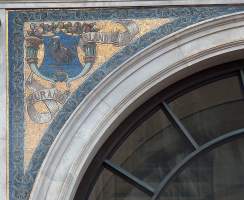
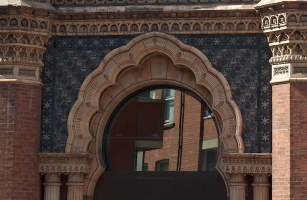
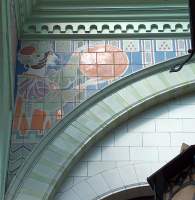 Coloured tile and mosaic for spandrels.
Coloured tile and mosaic for spandrels.
Shields are also popular among foliage, as shown by the two examples below. To the left, again combined with figural work in the form of caryatids and a medallion portrait in the curved pediment above, we see cartouche shields with minor Acanthus additions. As with the snake example above, the shields take up a rectangle based on the right angled corner of the spandrel, with the scrolly foliage left to the smaller remaining triangles. This is from the Royal Arcade off Piccadilly in Albemarle Street. Below right is an example from the old City of London School building, thus early Victorian, showing a more conventional use of shields in spandrels, more or less in the same positions as the Piccadilly example, but small enough that the foliage around is more dominant.
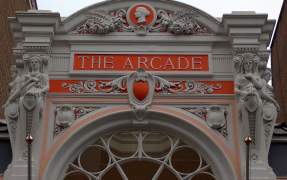
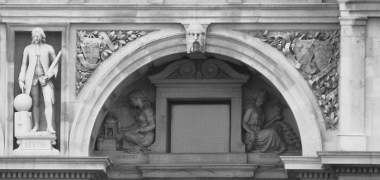 Shields and sculptured foliage.
Shields and sculptured foliage.
Another shape fitting nicely in this central position of the spandrel to leave two side triangles is the circle – thus a roundel, which can be large enough to touch the arch, and occupy the right angled corner. Here we see a fine example with portrait heads in roundels, with scroll acanthus and the odd fruit filling the rest of the space. One roundel has a rodent accompanying the personage. Next, a medievalised example, more geometric, with the roundel enclosing interlinked and overlapping circles in a quatrefoil, with teardrops extending into the long corners. The smaller shapes are then used to incorporate angels and flowers. Next, an example with a smaller roundel within the spandrel, well away from touching the sides or the arch, as a wreath enclosing a sculpted half figure of a king holding small ecclesiastical building. Crisp work from the turn of the century. Then a genuine medieval example, the roundel enclosing a shield looking more like a face from African art, with the remaining triangles housing an angel, and a pelican (it looks more like a swan) feeding her young; in both cases the long corner is occupied by a wing.
Sculpture based on circles in spandrels.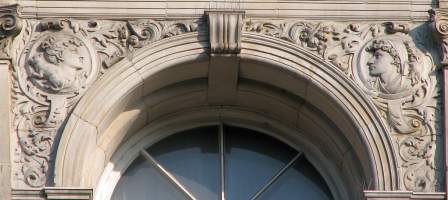
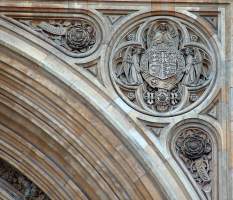
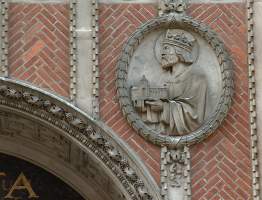
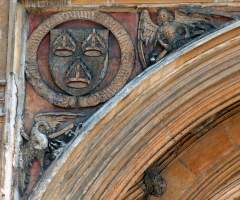
The double spandrel between two arches also allows for a roundel. Below left, little roundels with attached sculpted heads of medieval style figures. Centrally, a roundel touching both arches and the top of the spandrel, enclosing a bust of Shakespeare; the background in the small remaining triangles is occupied by deeply cut foliage and flowers in this most accomplished example. And to the right, a perfect Arts and Crafts example, with the roundel implied from the swirling scrolls and acanthus leaves, and enclosing a perfect symmetrical head of an ideal girl, in pink terra cotta.
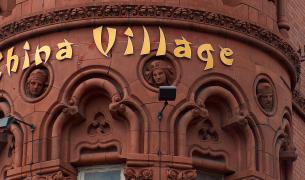
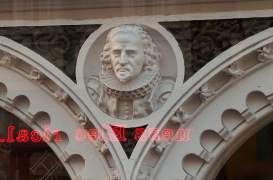
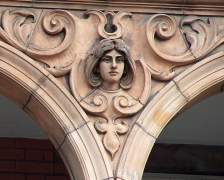 Double arch spandrels with roundels.
Double arch spandrels with roundels.
Symmetrical, ideal faces bring us neatly on to angels, of which there are many examples in architectural sculpture, some of which are in spandrels. Below left is a male angel in a broadened spandrel, thus leaving a single long corner, into which one of his wings is neatly fitted, an arm in front. The other wing takes the right angle, and the breadth of the spandrel base allow for his legs to be well apart, emphasizing the muscularity of the figure and allowing for the figure to take a star shaped pose, with a limb towards each corner of the irregular shape. Next, a conventional female angel, wings in the two upper corners, feet down in the long vertical corner in the usual fashion. At first glance she appears to be posed towards the arch rather than away from it, but this is only half the case – she is seated facing slightly outwards, as we can see from her right knee and lower leg, and it is her upper body which is elegantly twisted so her breasts and shoulders point forward, and her head slightly towards the centre. This is found elsewhere with spandrel angels; the third example below, unfortunately with an over-intrusive anti-pigeon net, is a particularly charming angel, lightly draped, in similar pose, but with more twist: hips and downwards facing outwards, upper torso forwards, head turning far inwards. This rotation of the body echoes the S shape of her body, and the soft zig zag of her arms, giving a particularly harmonious whole. The right hand example shows angels as half figures coming forward from the spandrels, single and double. The double spandrel angel comes straight forward, wings symmetrical, with studied asymmetry introduced through the drapery and the small cornucopia she holds. The single spandrel angel though certainly breaks our convention by facing wholly inwards to the arch. To accommodate the opposing curves of the arch and her body, she has to overlap slightly with the side of the arch, fine for a sculpted figure in the round, but which would have been difficult to accomplish in a satisfactory way had the sculpture been merely in high relief, thus being parallel with rather than in front of the arch.
Below, a couple more of these spandrels with figures coming right forward – both of them being caryatids (a discussion of such figures is on this page). To the left, another half figure, in front of a double spandrel. As with the angel above, the sculptor has seen fit to avoid symmetry through the drapery, position of the arms, and the gaze of the figure. The right hand example, male, occupies a single spandrel, and is barely attached to the architecture behind. He not only covers the floral spandrel, but rises above its upper limit, which is unusual.
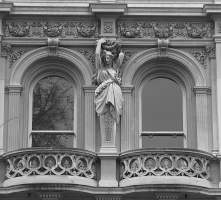
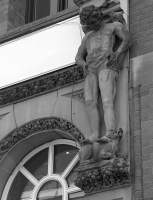 Figures leaning forward from spandrel positions.
Figures leaning forward from spandrel positions.
We should mention unusually-shaped spandrels too. Our first example below shows a portico, sculpturally rich, where the spandrel has been raised to the point where a broad rectangular field is produced with downward turned corners. The construction within, with round window, cherubs to the side, festoons of flowers and S-shaped scrolls, hearkens back to the 18th Century. Compositionally, the spandrels are occupied by the S-shaped scrolls rather than the cherubs, and indeed the latter, together with the festoons, rather mirror the arch underneath. The second example is novel – as with the male caryatid above, the figures rise above the spandrel position, in this case by having an open pediment above into which they can rise. The spandrels proper are occupied only by the legs of the figures; their elbows jut towards the corners of the pediment. The composition of unclothed muscular figures gives the eye good lines to follow: the stretched out legs providing a second arch above the real arch; the raised knees breaking the barrier between spandrel and pediment, the forearms and hands of each figure suggesting curved lines outwards from the centre. Breaking most of our spandrel conventions, we still have the figures seated facing outwards, one leg each into the vertical spandrel corner, and with a twist of the body so the faces turn inwards towards each other and across the body of the central cherubic figure, who also acts as an extension of the keystone of the arch below. Clever work by the sculptor Richard Garbe. The third example, non-figural, is a double archway where the breadth of the frames has been increased so as to reduce the double spandrel to a shallow five-sided shape, accommodating minor floralities around a cartouche, little more than a setting for the strange bird above the central pillar. And the colourful building on the right, a charming little Turkish Bath in the City of London, has a Moorish arch with consequently odd-shaped spandrels which have been filled with an exotic scrolling design in high relief, much under-cut.
Another less usual treatment of the spandrel is to cut it up into segments. Below left, a fine example of terra cotta from Manchester, a double spandrel has become a third arch containing some sculpted shell design radiating outward from a star on a cartouche, and the two side spandrels, with two curved sides, give room for helmeted cherubs holding shields. Even here we preserve the convention that the figure is seated away from the arches, with an extended leg towards the long downward spandrel corner, and as they are winged, putting one wing towards the long horizontal corner. In this case, to fill the right angle corner, the left hand figure carries an Askelapaean staff, the right hand one, a torch. The middle example takes a raised spandrel and divides it into three compartments left to right, so that the central compartment is almost rectangular, and the outer ones are truncated wedges. The dainty semiclad girls, we hardly need point out, are seated outwards, extended foot towards the rather blunt vertical spandrel corners, and in this case the dividing vertical providing almost a backrest for each figure. The figure on the right faces away from us so that looking across from one to the other we have a pleasing variety to the eye – this reversal has always been a common compositional device in drawings of paired figures. We have seen how a roundel in a spandrel, or a smaller figure, divides off two smaller triangles, and the example below right segments the spandrel entirely with horizontal and vertical to provide three entirely distinct compartments; a further central divide means there is no long horizontal corner. The three compartments are occupied by three, one and no sculpted figures respectively, but in each case are compositions based on a series of curves.
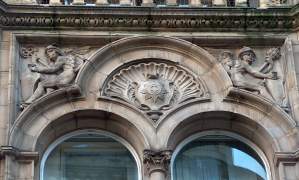
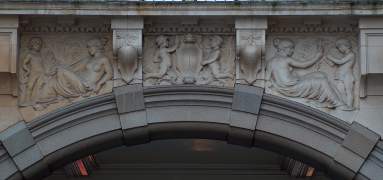
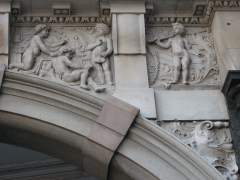 Sculpture in divided spandrels.
Sculpture in divided spandrels.
Three more examples to show the variety of spandrel shapes. Below left, a pointed frame above the round arch leaves two spandrels with no long vertical corner; regardless the outward facing pair of girls have legs extended to where those corners would have been; the breadth of the spandrels allows for subsidiary cherubic figures, and it is seen that the majority of the spandrel space is occupied. Below centre, a raised spandrel above a curvy pediment, broken and open, above a curved arch, gives spandrel shapes based on an S-shaped curve. All sorts of things could have filled such a shape, but the sculptor has chosen fructifying festoons and winged cherubic heads, leaving a considerable proportion of the background empty. The portico below right, on a photo which for some unaccountable reason tilts to the left, shows how a spandrel position can arise without a proper arch; rather, we have a curved pediment where the receding side pilasters and horizontal frame below the upper floor give rather free-style spandrel positions, occupied by fully detatched sculptured figures. These rather Hellenistic girls, in principle free from the spandrels in that there is no physical border to restrain them, follow our familiar conventions – lower body facing outward from the curve, upper body gently twisted inwards so the breasts point directly forwards, leg extended to the vertical corner position.
Architecture pages // Sculpture pages
Visits to this page from 13 Mar 2014: 8,144 since 22 March 2021